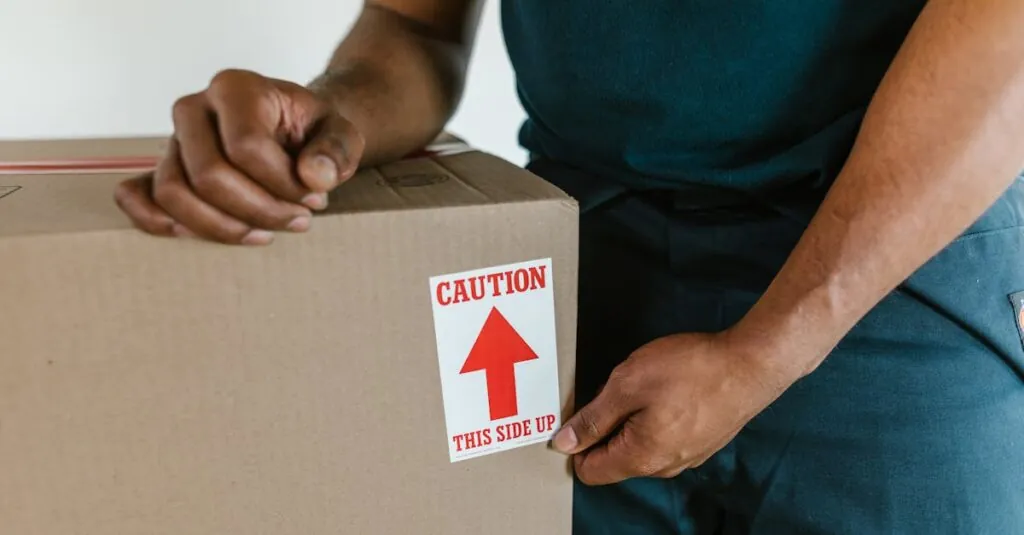Table of Contents
ToggleMoving can feel like a circus act, with boxes flying and furniture tumbling. When the dust settles, it’s time to show appreciation for the real MVPs: the movers. But how does one navigate the tricky waters of tipping? It’s not just about tossing a few bucks and calling it a day.
Understanding how to tip movers can make all the difference. A well-timed tip can transform a good moving experience into a great one, leaving everyone smiling. After all, these heroes are the ones who hoisted your grandma’s antique armoire and wrestled your sofa through tight doorways. So, let’s dive into the art of tipping movers and ensure they know just how much their hard work means.
Understanding Tipping Etiquette
Tipping movers reflects appreciation for their hard work. It also contributes to a positive moving experience.
The Importance of Tipping Movers
Tipping movers acknowledges their effort and dedication. Many movers face physically demanding tasks, often requiring them to navigate tight spaces or handle heavy items. Recognizing this contribution fosters a sense of morale and encourages quality service. Tips serve as a token of appreciation, enhancing relationships between clients and movers. An appropriate tip can motivate individuals to provide exceptional care for belongings, ensuring a smoother transition.
Factors Influencing Tips
Several factors determine the amount to tip movers. The overall complexity of the move directly impacts tipping. A larger home or challenging circumstances, like stairs, may warrant higher tips. Time spent working also plays a crucial role; longer moves typically attract increased compensation. Experience and professionalism of movers can influence tips as well. Professionalism enables efficient handling, while courtesy improves interaction. Finally, local customs establish typical tipping ranges, which can offer additional guidance for clients.
How Much to Tip Movers
Determining the right amount to tip movers hinges on several factors. Guidelines suggest tipping between 10% and 20% of the total moving cost. For local moves, aim for $20 to $30 per mover. Longer distance moves often see tips of $50 to $100 per mover, depending on complexity.
General Guidelines
Tipping starts with evaluating the move’s complexity. Consider the number of items moved and the distance traveled. A move that includes stairs or requires heavy lifting typically warrants a higher tip. Also, factor in how long the movers worked. If they worked quickly and efficiently, a larger tip reflects appreciation. Calculate the total cost of the move, and then determine a percentage that fits the service level.
Considerations for Special Circumstances
Special circumstances may affect the tipping guidelines. If the movers show exceptional care with fragile items, consider tipping more. Inclement weather should also prompt a larger tip due to challenging conditions. If any movers go beyond their duties, like providing furniture assembly or specialized packing, it merits an additional gratuity. During holidays, generosity often increases due to heightened demand, so adjust the tip accordingly.
Methods of Tipping Movers
Tipping methods can vary based on personal preferences and the specific context of the move. Understanding the difference between cash and non-cash tips is essential for expressing appreciation.
Cash Vs. Non-Cash Tips
Cash tips remain the most common choice. They provide immediate benefits and flexibility for movers. Offering cash shows appreciation simply and effectively. Non-cash options, such as gift cards or meals, might also work. Some may prefer these alternatives as they allow for personalization. However, cash tips directly support movers and are universally appreciated.
Tips for Different Moving Services
Specific tipping guidelines exist for different moving services. For local moves, he or she may recommend $20 to $30 per mover. Long-distance moves typically warrant higher amounts, like $50 to $100 per mover. Complexity factors in significantly. Numerous items, difficult access, or special requests can justify increased tips. Exceptional service deserves recognition, so adjust amounts accordingly.
When to Tip Movers
Timing of tips plays a crucial role in ensuring movers feel appreciated. It’s essential to consider the most effective moments to express gratitude.
Timing Your Tips
The right moment to tip movers involves assessing the flow of the move. Tipping before the job initiates can motivate workers to perform at their best. Conversely, giving a tip halfway through allows for real-time assessment of their effort and professionalism. Consider tipping after each significant task so they understand that hard work earns recognition. Keep in mind specific highlight points, like the packing of fragile items or navigating challenging staircases.
After the Job Completion
Tipping after job completion is often the most common approach. Once the movers have unloaded and set up items to your satisfaction, you can present your tip. This timing ensures appreciation reflects the entire service provided. Review the job quality and effort displayed, keeping rate guidelines in mind. If they went above and beyond, consider tipping at the higher end of the scale. Ultimately, ensure the amount reflects service quality while expressing genuine gratitude for their hard work.
Tipping movers is an essential way to show appreciation for their hard work and dedication. A thoughtful tip not only acknowledges their effort but also contributes to a positive moving experience. By considering factors like the complexity of the move and the level of service provided, individuals can determine an appropriate tip amount that reflects their gratitude. Whether opting for cash or a non-cash gesture, the key is to ensure the movers feel valued for their contributions. Ultimately, a well-timed and generous tip can make a significant difference in the overall satisfaction of both the movers and the clients.







